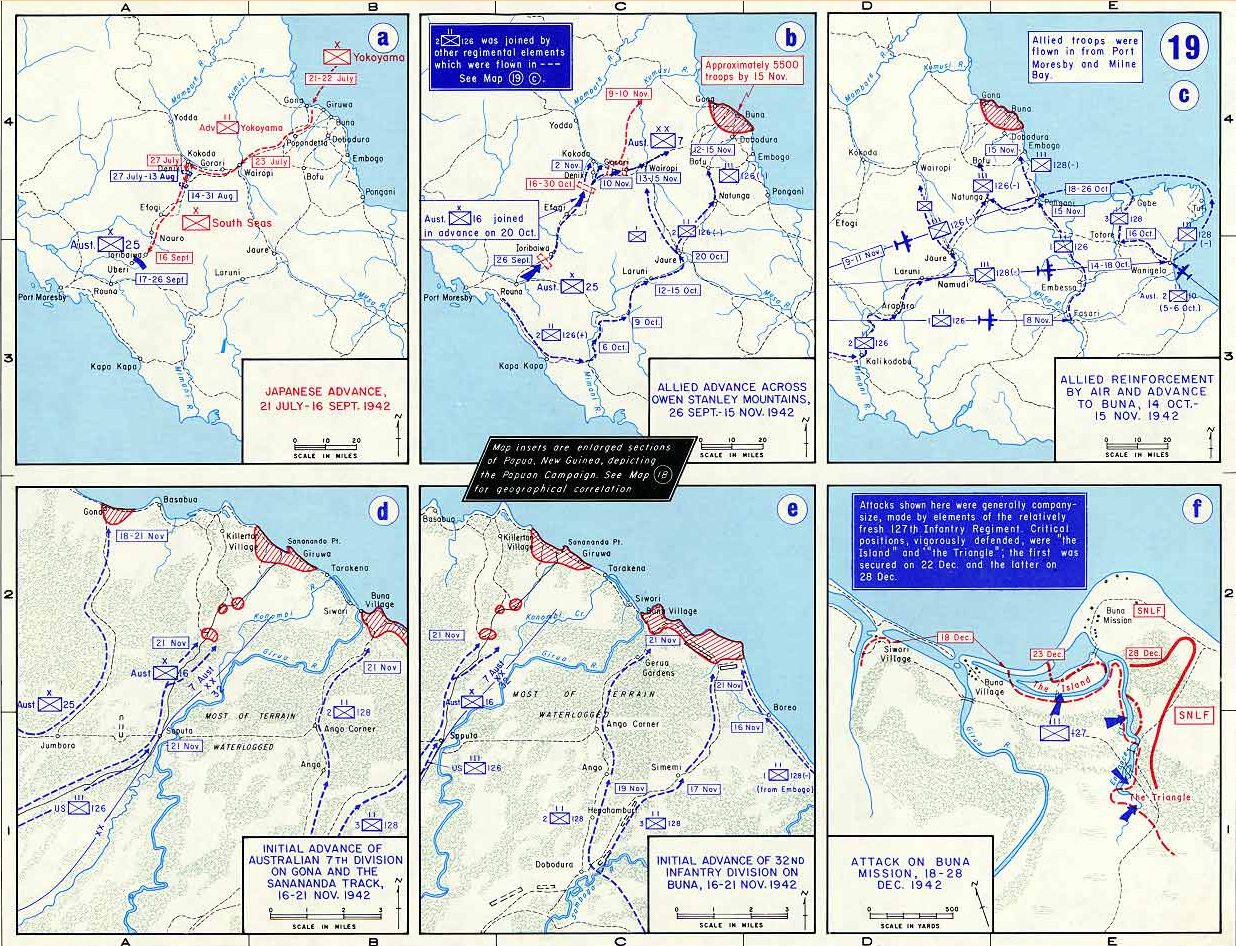Map Description
History Map of WWII: The New Guinea Campaign September — December 1942
Map insets are enlarged sections of Papua, New Guinea, depicting the Papuan Campaign.
See this map for geographical correlation.
Illustrating:
Map ⓐ
Japanese Advance, July 21 - September 16, 1942
On July 21, 1942, Japanese forces landed at Buna and Gona on the northern coast of Papua, initiating their campaign to
seize Port Moresby and thereby threaten Australia’s northern approaches. The initial defenders, including the Australian
39th Battalion, were ill-equipped and lacked adequate medical support, forcing a fighting retreat along the Kokoda Track
through dense jungle and rugged mountains. Despite fierce resistance, the Japanese pressed southward, but their advance
was ultimately stalled by a combination of determined Australian defense, disease, and severe supply shortages by
mid-September.
Map ⓑ
Allied Advance Across Owen Stanley Mountains, September 26 - November 15, 1942
Following the halt of the Japanese advance, Australian forces, reinforced and resupplied, began a counteroffensive across the Owen
Stanley Mountains in late September 1942. The treacherous terrain and harsh weather posed immense logistical and medical challenges,
but the Allies gradually pushed the exhausted Japanese back along the Kokoda Track. By early November, the Australians had
recaptured Kokoda village, reversing the momentum and securing vital ground for the continued Allied push toward the enemy
coastal strongholds.
Map ⓒ
Allied Reinforcement by Air and Advance to Buna, October 14 - November 15, 1942
With the recapture of Kokoda, the Allies strengthened their positions by airlifting reinforcements and supplies into forward areas,
a significant logistical achievement that enabled sustained operations in the difficult terrain. American portable hospitals were
introduced, improving casualty care as the combined Australian and American forces advanced toward the Japanese beachheads at
Buna and Gona. This period saw the Allies consolidating gains and preparing for the major assaults on the fortified coastal positions
that would follow.
Map ⓓ
Initial Advance of Australian 7th Division on Gona and the Sanananda Track, November 16 - 21, 1942
On November 16, 1942, the Australian 7th Division began its advance on Gona and along the Sanananda Track, targeting Japanese
defensive positions that had been heavily reinforced and entrenched. The initial attacks encountered fierce resistance, with the
Japanese making effective use of bunkers and the dense jungle to inflict heavy casualties. Despite these difficulties, the
Australians managed to gain ground, setting the stage for prolonged and bloody fighting in the coming weeks.
Map ⓔ
Initial Advance of 32nd Infantry Division on Buna, November 16-21, 1942
As the Allied focus shifted to the Japanese stronghold at Buna, the American 32nd Infantry Division undertook its first assaults
on the fortified positions beginning November 16, 1942. The division, largely inexperienced in jungle warfare and hampered by
logistical difficulties, quickly became bogged down against determined Japanese resistance. Recognizing the gravity of the
situation, General Douglas MacArthur dispatched Lieutenant General Robert L. Eichelberger to take
direct command on the ground.
Eichelberger’s arrival marked a turning point: he reorganized the exhausted American troops, improved discipline, and personally
led from the front, inspiring renewed aggression in the attacks on Buna. His leadership was instrumental in stabilizing the front
and setting the stage for the final push to break the Japanese defenses.
Map ⓕ
Attack on Buna Mission, December 18-28, 1942
The culmination of the Buna campaign came in late December 1942, as Allied forces mounted a concentrated assault on the Buna Mission.
Under the direct command of General Eichelberger, the 32nd Infantry Division-now reinforced and revitalized-pressed home repeated
attacks against the Japanese, who were entrenched in formidable bunkers and suffering from starvation and disease. Eichelberger’s
insistence on aggressive tactics and his willingness to expose himself to frontline risks galvanized the American troops, ultimately
leading to the capture of Buna Mission. This victory, achieved at significant cost, marked the first
major Allied success against Japanese ground forces in Papua and was a testament to Eichelberger’s decisive leadership during a
critical phase of the campaign.
Credits
Courtesy of the United States Military Academy Department of History.
Related Links
About World War IIWWII Timelines

